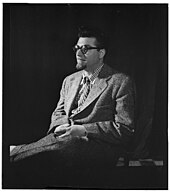George cell phone
George Handy (born George Joseph Hendelman , * 17th January 1920 in New York City , † 8. January 1997 in New York City) was a jazz - arranger , composer and pianist . He will be remembered for his arrangements and compositions reflecting new music.
Live and act
Handy played the piano at the age of five and initially received lessons from his own mother. Childhood friends included Terry Gibbs , Al Cohn , Tiny Kahn, and Frank Socolow . He briefly studied at the Juilliard School of Music in New York and took private lessons with Aaron Copland for a while . He first worked as a swing pianist for Michael Loring in 1938 , but was drafted into the US Army in 1940 . He then arranged for Raymond Scott's Orchestra, for Les Brown and for Jack Teagarden . In 1943 he led his own band. From 1944 to 1946 he was a member of the Boyd Raeburn Orchestra , which at the time, like some other big bands , focused on the bebop . There he arranged, composed and played the piano. It created complex works such Tonsillectomy and Dalvatore Sally , some of the Progressive Jazz are slammed shut. He left the orchestra to work for Paramount Studios for six months , but then returned to Raeburn. During this time Handy was at its most creative and also wrote arrangements of old standards in bebop style.
In 1946 Handy finally left the Raeburn formation. In that year he also took part in the recording of Diggin'Diz by Dizzy Gillespie and Charlie Parker and had the opportunity with a big band and strings to contribute his piece "The Bloos" commissioned by Norman Granz to the compilation The Jazz Scene . Although he continued to arrange for other groups, his time with Raeburn from 1944 to 1946 was the most successful; afterwards he started therapy because of a drug addiction. He was only able to resume his career in 1954. For the label X (which belonged to RCA), two albums were created under his name: Handyland USA (1954) and By George: Handy of Course (1955); he also performed in Birdland . In 1955 Eddie Caine commissioned him to compose a flute piece; the result was the multi-movement The Caine Flute Sonata , which took up trains of the Third Stream . George Handy played in the Zoot Sims Quintet in 1956 when recording the album Zoot! With; a rare opportunity to hear the pianist in a small cast. With Zims, two more albums were created in 1956 and 1957. He also arranged for Hal McKusick's album Cross-Section Saxes (1958). Until the mid-1960s he devoted himself to three saxophone quartets and a saxophone suite in eight movements, which he composed for the New York Saxophone Quartet (with Caine, Ray Beckenstein , Al Epstein , Danny Bank ). Sometimes he also worked as a music critic for the specialist magazine Down Beat .
In 1968 Handy took a job as a pianist in the house band at a hotel in the Catskill Mountains . He later became a band leader at the Granite Hotel , where he ended his musical career. In the 1980s he attended a performance of his The Caine Flute Sonata . The Bloos (1946) is the best known of his own recordings .
Selection discography
- Charlie Parker: The Complete Savoy and Dial Recordings (Savoy, 1944-48)
- Boyd Raeburn: More 1944-1945 (Circle), Man with the Horns (Savoy, 1945-46)
- Handy country USA ( X.1954 / BMG 1998)
- By George: Handy of Course (1955; re-released as Pensive on Fresh Sound Records 2007)
- Zoot Sims: Zoot! (Riverside / OJC, 1956)
literature
- Yanow, Scott: Bebop , Miller Freeman Books, 2000 ISBN 0-87930-608-4
- Benjamin Biermann The Music of George Handy . Dissertation (City University New York) 2006
Web links
- George Handy at Allmusic (English)
- George Handy at Discogs (English)
| personal data | |
|---|---|
| SURNAME | Cell phone, George |
| ALTERNATIVE NAMES | Hendelman, George Joseph (real name) |
| BRIEF DESCRIPTION | American jazz musician (piano, arrangement, composition) |
| DATE OF BIRTH | 17th January 1920 |
| PLACE OF BIRTH | New York City |
| DATE OF DEATH | January 8, 1997 |
| Place of death | New York City |
